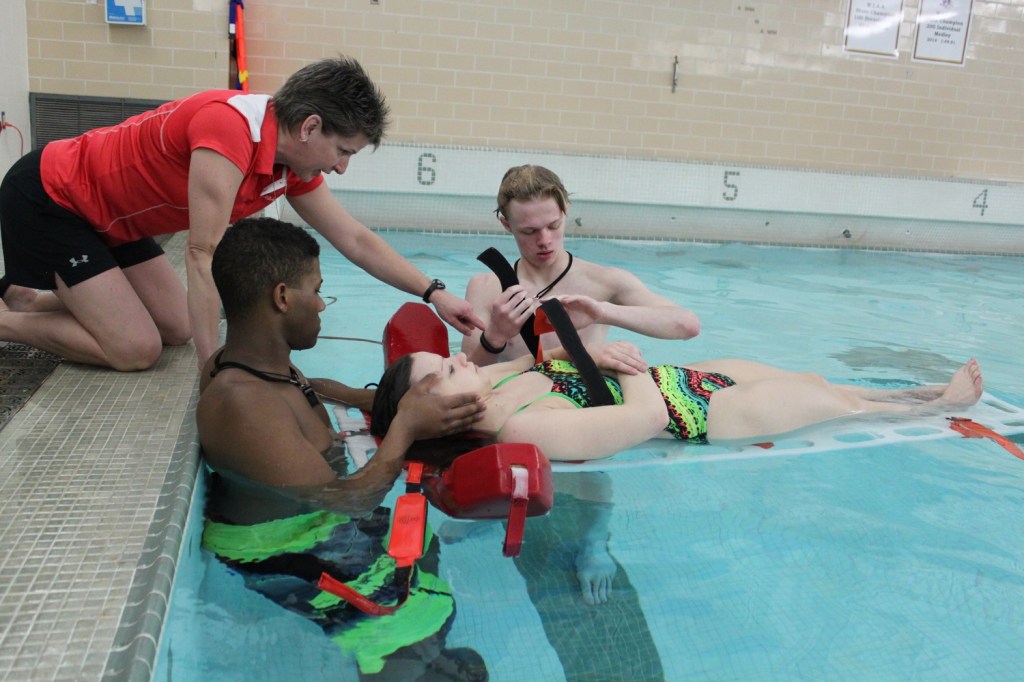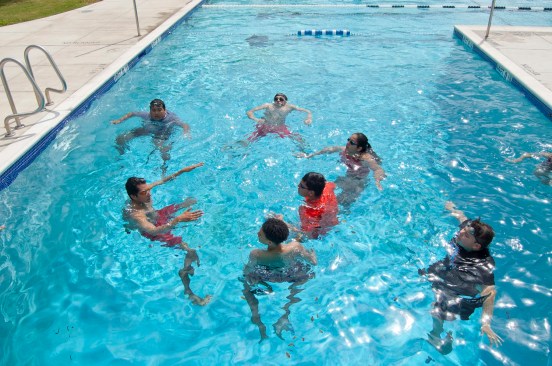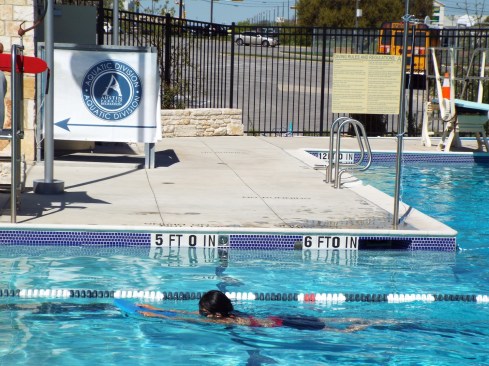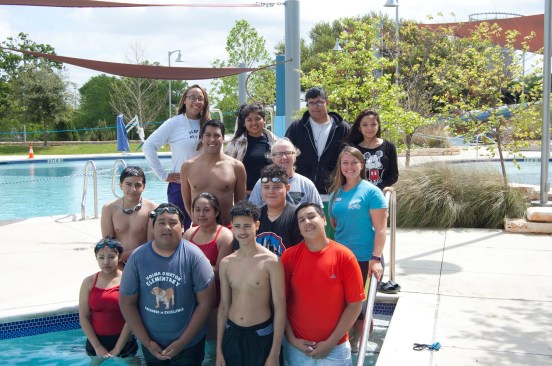Brooke Klein Gebbinck speaks from experience when she reminds students that lifeguarding isn’t a bad fallback career.
She planned to become a school teacher after receiving a bachelor’s in English, but it was through lifeguarding that she found a teaching job of a different sort. Among her many duties as supervisor of child, youth and aquatics at the Midland YMCA in Ontario, Canada, she helps teens earn school credit learning a marketable skill — lifeguarding.
Many high schools in Canada award students physical education credits when they train through the Lifesaving Society’s National Lifeguard Service, the country’s professional certification. It’s how Klein Gebbinck, herself, was introduced to the profession when she trained through Catholic school 12 years ago. She’s been in the aquatics industry ever since.
She credits Canada’s forward-thinking curriculum for supplying half of her pool staff. “That’s why I really push for this program,” she says. “It’s a great opportunity for them, but also benefits me.”
Learning water-rescue techniques for class credit isn’t unique to the Great White North. Similar courses are being taught in the United States, where schools are broadening the scope of physical education. Gym class is no longer just rope climbing.
A big hurdle to kids getting lifeguard certified is having the time to do it outside of their school day and having the resources to be able to go do it.
Educators say there is a movement toward specialty PE classes where students can develop an interest in healthy activities that they could continue to pursue in the real world. That’s how lifeguard training has become an option in recent years alongside martial arts, competitive dance and yoga, among other unconventional electives at some schools.
This is good news for aquatics facilities that have had to reduce pool hours or close entirely due to severe staffing struggles. The lifeguard shortage has been vexing the industry for years, as many youths would rather work in retail than be responsible for people’s lives.
However, there are those who think a summer job by the pool would be a pretty sweet gig, but don’t have the means to train and pay for the certification. Fortunately, some schools are removing those barriers by covering the costs of learning materials and related fees. As a result, students now are considering extrication drills over dodging balls.
“A big hurdle to kids getting lifeguard certified is having the time to do it outside of their school day and having the resources to be able to go do it,” says Allison Finn, wellness department chair at Mundelein High School in suburban Chicago. “If you offer it right there, kids will take it.”
These schools pride themselves on producing topnotch guards. Teaching the course over an entire quarter or semester allows instructors to develop weak swimmers into strong swimmers and refine rescue techniques. The old adage “practice makes perfect” certainly applies here.
For many instructors, this is preferable to the intensive weeklong sessions taught by agencies outside the school system. Those programs aren’t as patient. “If the kid doesn’t get the skill, you have to move on because all these other people paid $300 or $400 for the class,” says Dave Davis, aquatic director at York Community High School in Elmhurst, Ill. “You can’t just stop and take your time with one student.”
The school, which has four certified Red Cross instructors on staff, currently has 16 students enrolled in the class and 21 signed up for next year. Davis estimates that at least half go on to become paid lifeguards.
Because the program is proving ever popular, York’s administrators aren’t taking chances when hiring new PE teachers. They must be competent swimmers and willing to become certified instructors. Applicants can expect to bring a pair of swim trunks to the job interview. PE Department Chair Lauren DeAngelis runs candidates through the several drills to see if they could pass the Red Cross exam that would qualify them to teach the course. Those who flunk can find work elsewhere. “I definitely can’t have them tell me they can pass the test and then not,” DeAngelis warns.
Here are several innovative ways schools are training up the industry’s future rescuers.
Making the grade
City of Austin
An instructor goes over the fundamentals of swimming with studen…
A new program in Austin, Texas, isn’t letting a small thing like lack of ability get in the way of a student’s desire to become certified.
SwimATX is a course that focuses on the fundamentals of swimming to prepare students to qualify for the Red Cross course.
Unlike other lifeguarding programs that bar students from enrolling based on a poor tryout, SwimATX believes if there is a will, there is a way. It works with kids who have minimal skills and shapes them into competent guards.
“We’re trying to build their strength, refine their stroke and get them to where they can physically pass the Red Cross prerequisites,” says Wayne Simmons, the city’s aquatic program manager.
A partnership between the city of Austin, the YMCA and the Austin Independent School District, the program is in its third semester and so far has certified 36 students.
“They started as not very good swimmers, only able to swim 10 to 25 yards max,” Simmons says.
It doesn’t cost students a thing to take the class. SwimATX aims to remove all obstacles from youths who want to pursue careers in aquatics. That includes transportation. Buses deliver students to and from city-owned and YMCA pools during school hours. Thanks to generous sponsors, they get free goggles and swimwear.
SwimATX not only helps fill out the city’s roster of 650 to 750 seasonal pool employees, but it’s also fostering diversity. The program works with two high schools with large Hispanic and African-American populations.
“The community would like a better representation of itself in our lifeguarding staff,” Simmons says.
The syllabus includes 12 to 16-weeks of swim instruction and concludes with five days of training for the Red Cross certification. Because this falls on finals week, the schools allow students to take their academic exams the week prior, so they can focus on the intensive training.
Evidence of success can be seen in the new-to-them cars that students are buying thanks to their part-time pool jobs.
“That’s really created excitement for the kids,” Simmons says. “They can tangibly see the benefits of the program.”
Teachers take it seriously
At the Eau Claire Area School District, lifeguarding is as popular with students as it is with teachers. In addition to several Red Cross-licensed instructors, there are 36 staff members currently certified as lifeguards between the district’s two high schools.
They tend to cause a bit of a sensation with the local media when they recertify. People in their 50s and 60s retrieving bricks from the bottom of a pool make for an irresistible photo op.
“They could film an episode of ‘Baywatch: The Later Years,’” jokes Kari Winkler, PE department chair at Memorial High School.
Kidding aside, it’s a point of pride that all teachers know how to rescue.
We tell them ‘You have some of the best and brightest kids in lifeguarding at your disposal.
Winkler helped resurrect the district’s student lifeguard training curriculum after it vanished for a number of years. To offset the course costs, she suggested offering students a scholarship, but administrators determined the class should be free.
Winkler was admittedly nervous about that, fearing that the program would be the first on the chopping block during budget cuts. But it’s been going five years strong now.
The schools invite local aquatics facilities to job fairs and talk up their students. “We tell them ‘You have some of the best and brightest kids in lifeguarding at your disposal,’” Winkler says.
The result is an impressive 80 percent job placement rating, she adds.
Lifeguards as leaders
Recognizing that lifeguarding is about teamwork and accountability, one suburban Chicago school integrated water rescue into a student leadership course.
Introduced in the fall of last year at Mundelein High School, the extracurricular program provides opportunities to juniors and seniors to serve on boards overseeing social events and community service projects. Once certified through Starfish Aquatics Institute, they also can guard over freshmen at the school’s newly renovated pool.
We like to have a partnership with the park district so they can use our kids.
Among the 80 students who participated this year, half passed the rigorous testing to become Starguard Lifeguards. They shouldn’t have a hard time finding jobs. The school switched to SAI from another vendor shortly after the Village of Mundelein began requiring the certification.
“We like to have a partnership with the park district so they can use our kids,” says Allison Finn, wellness department chair.
Training with the Pros
How does an instructor fill an entire semester with material that’s commonly taught in a week?
With creativity.
To keep young minds engaged, Karen Baldez invites EMS professionals to roleplay with lifeguards-in-training through various scenarios. The goal is to better prepare them for real-world emergencies where other agencies might be involved.
“It gives them some first-hand, practical experience talking and working with EMS in general,” says the aquatics instructor at Cheyenne Mountain High School in Colorado Springs, Colo.
She applies the same principle when teaching the school’s Water Safety Instructor course. Instead of emergency responders, it’s real-life, real squirmy, kids. Before the end of the semester, high schoolers get to teach elementary students how to stay afloat.
A recent session had 56 fourth graders in the pool taking instruction from 16 newly christened WSIs.
“It was so super cool,” Baldez enthuses. “For some of those kids it was their very first swim lesson.”
Common cause
While there are nuances to how these lifeguarding classes are conducted, i.e., different approaches to grading, blended learning, etc., the goals are the same: Equip kids with lifesaving skills and increase their job prospects.



